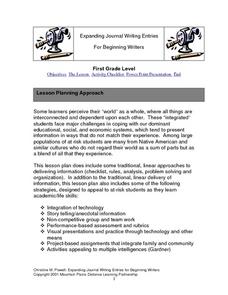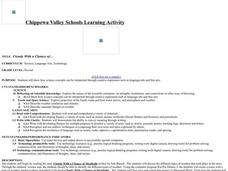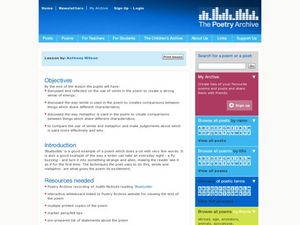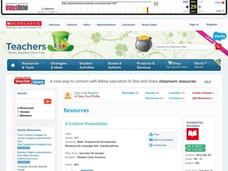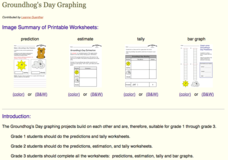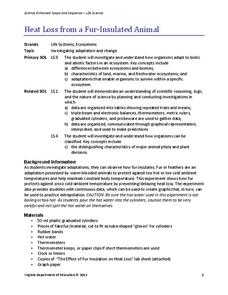Curated OER
Expanding Journal Writing Entries For Beginning Writers
First graders through a variety of strategies assess how to write in journals openly and effectively. Those strategies include integration of technology, story telling, group and team work, performance-based assessment/rubrics, visual...
Curated OER
Patterns
Fourth graders investigate patterns and sequences. In this patterns and sequences lesson, 4th graders use a hundreds chart to build recurring patterns. Students skip count by threes and fives on a hundreds chart by coloring multiples...
Curated OER
Model and Solve Algebraic Equations
Examine multiple ways to solve algebraic equations. Pupils will generate a problem solving strategy that addresses the prompt given by the teacher. They will then share their problem solving strategy with the class. Graphic organizers,...
Curated OER
Tarantula Girl
In this reading comprehension worksheet, students read a two page true story about a girl who loves tarantulas. Students complete a 12 question multiple choice quiz on the story. There are four additional reading comprehension stories...
Curated OER
The Five Number Game
Learners explain what it means to square numbers. They explain what it means to cube numbers. Students define prime numbers using their own language. They are introduced to the problem by playing one game as a class.
Curated OER
Learning Grammar Through Wordplay
Young scholars use wordplay to investigate the grammatical components of a sentence. They read a New York Times article by analyzing the writer's use of nouns and verbs in the article and then constructing original sentences using those...
Curated OER
Ingredients of a Mystery
Students explore the concept of mysteries. For this mystery genre lesson, students identify the common characteristics of mystery books and use a story map to identify these characteristics in a given book. Students also discover the...
Curated OER
Kids Need Natural Resources
Third graders define renewable and non-renewable resources and give multiple examples of each type of resource. In this environmental science lesson, 3rd graders sort picture cards into two categories, renewable and non-renewable...
Curated OER
Making Inferences about Problem and Solution
Students use unfamiliar objects to make inferences. In this making inferences lesson plan, students make guesses about what an item does. Students brainstorm together and make lists of ideas and write them on index cards. The teacher...
Curated OER
Into the Wild,
Students study the importance of point of view. They use a well-known fairy tale to explore how changing the point of view changes the whole story. They discuss what "point of view" means by asking: whose story is it? Whose eyes are we...
Curated OER
Readers Theatre: Presenting Historical Events Through Theatre
Students examine historical events. In this lesson on the US Constitution, students engage in a theatrical exploration of the Constitution and the Bill of Rights. They also engage in an extensive discussion, complete worksheets and draft...
Curated OER
West Virginia State Museum Lesson Plan
Students explore historic West Virginia. In this US history instructional activity, students examine primary sources and political cartoons that depict the issues of statehood for West Virginia and the role that those played in the Civil...
Curated OER
- Making Metaphors with Munchies
Students brainstorm independently first, then ask their best friend on the team, or seat partners, depending on the year & student mix, to add to their list of personal characteristics and/or to name three words they think of...
Curated OER
Why We Need Sleep
Fifth graders track how much sleep they get and list reasons sleep is important. In this health and math lesson plan, 5th graders keep up with their sleep times for a week and make notes about how they feel each day prior to the lesson...
Curated OER
Cloudy With a Chance of...
Second graders will write a story. In this writing and meteorology lesson, 2nd graders read the story Cloudy With a Chance of Meatballs, then use KidPix to create a weather picture. The picture is imported into a word processor and the...
Curated OER
Bluebottle
Students read the poem Bluebottle and discuss the use of the simile in the poem. In this Bluebottle poetry instructional activity, students analyze the use of verbs and the energy created by that use. Students text mark all the similes...
Curated OER
Elements of Fables
Students explore the attributes of fables. In this literature instructional activity, students read several fables and identify the moral instructional activity, characterization, and figurative language in each. Students then retell...
Curated OER
A Creative Presentation
Bring writing to life with this lesson in which elementary and middle schoolers create a display of the imagery they identify in a series of Gary Paulsen books. They read the suggested materials, identify imagery and descriptive...
For the Teachers
Cause and Effect Matrix
Study cause and effect in both literature and informational text with a lesson designed for several different reading levels. After kids review the concept of cause and effect, they read an article or story and note the causes and...
Kid Zone
Groundhog's Day Graphing
This Groundhog's Day, challenge scholars to predict, estimate, tally, and graph in a weather-themed lesson in which class members play the role of the groundhog to forecast the weather come February second.
Bully Free Systems
Bully Free Lesson Plans—Eighth Grade
Middle schoolers are likely very familiar with the concept of bullying and cliques. Discuss their experiences and brainstorm ways to handle peer conflict and feelings of exclusion with a poem that focuses on bullying, and a second lesson...
Ogden Museum of Art Education Department
Literacy and Landscapes
As the saying goes, art often imitates life ... and literature! A series of activities designed to accompany a visit to the Ogden Museum of Southern Art encourage writers to find inspiration in various landscapes. The lesson includes a...
Illustrative Mathematics
Running to School
The object of this activity is to compute how far Rosa ran to school. Given in the exercise is the fractional number of miles between home and school and the fractional distance Rosa ran. The commentary shows several ways to have your...
Virginia Department of Education
Heat Loss from a Fur-Insulated Animal
How do animals adapt to weather changes? Provide your class with the ability to understand adaptations and body temperature as they participate in this hands on experiment, using fake fur and hot water. Pupils collect data and analyze...


